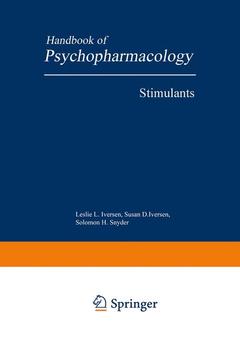Stimulants, Softcover reprint of the original 1st ed. 1978 Section I: Basic Neuropharmacology Series
Langue : Anglais

Underlying the design of the Handbook of Psychopharmacology is a prejudice that the study of drug influences on the mind has advanced to a stage where basic research and clinical application truly mesh. These later volumes of the Handbook are structured according to this conception. In certain volumes, groups of drugs are treated as classes with chapters ranging from basic chemistry to clinical application. Other volumes are assembled around topic areas such as anxiety or affective disorders. Thus, besides chapters on individual drug classes, we have included essays addressing broad areas such as "The Limbic-Hypothalamic-Pituitary-Adrenal System and Human Be havior" and "Peptides and the Central Nervous System. " Surveying these diverse contributions, one comes away with a sentiment that, far from being an "applied" science borrowing from fundamental brain chemistry and physiology, psychopharmacology has instead provided basic researchers with the tools and conceptual approaches which now are advancing neurobiology to a central role in modern biology. Especially gratifying is the sense that, while contributing to an understanding of how the brain functions, psychopharmacology is a discipline whose fruits offer genuine help to the mentally ill with promises of escalating benefits in the future. L. L. 1. S. D. I. S. H. S. VII CONTENTS CHAPTER 1 Amphetamines: Structure-Activity Relationships J. H. BIEL and B. A. Bopp 1. Introduction . . . . . . . . . . . . . . . . . . . . . . . . . . . . . . . . . . . . . . . . 1 2: Effects of Biogenic Amines . . . . . . . . . . . . . . . . . . . . . . . . . . . 2 2. 1. Norepinephrine. . . . . . . . . . . . . . . . . . . . . . . . . . . . . . . . 2 2. 2. Dopamine. . . . . . . . . . . . . . . . . . . . . . . . . . . . . . . . . . . . . 52. 3. Serotonin. . . . . . . . . . . . . . . . . . . . . . . . . . . . . . . . . . . . . . 8 3. Central Stimulatory Effects . . . . . . . . . . . . . . . . . . . . . . . . . . . 12 3. 1. Phenethylamine Derivatives. . . . . . . . . . . . . . . . . . . . . .
1 Amphetamines: Structure-Activity Relationships.- 1. Introduction.- 2. Effects of Biogenic Amines.- 3. Central Stimulatory Effects.- 4. Anorexic Effects.- 5. Inhibition of Monoamine Oxidase.- 6. Psychotomimetic Effects.- 7. Summary.- 8. References.- 2 Amphetamines: Biochemical and Behavioral Actions in Animals.- 1. Introduction.- 2. Chemistry.- 3. General Pharmacological Actions.- 4. Behavioral Effects in Animals Pretreated with Drugs That Modify Catecholaminergic Neurotransmission Processes.- 5. Behavioral Effects in Animals Pretreated with Drugs That Modify Noncatecholaminergic Transmission Processes.- 6. Interactions of Psychomotor Stimulants with Neurotransmitters in Brain.- 7. Comparisons of Biochemical and Behavioral Effects of d- and l-Amphetamine.- 8. Effects of Chronic Administration of Psychomotor Stimulants.- 9. Summary and Speculations.- 10. References.- 3 Central Nervous System Stimulants: Historical Aspects and Clinical Effects.- 1. Introduction—Early Use of Plant Preparations.- 2. Cocaine.- 3. Amphetamine and Methamphetamine.- 4. Phenmetrazine.- 5. Methylphenidate.- 6. Diethylpropion.- 7. Ephedrine.- 8. Clinical Aspects of CNS Stimulant Use.- 9. Medical Uses of Stimulants.- 10. Problems Raised by Stimulants.- 11. References.- 4 Drug Treatment in Child Psychiatry.- 1. Introduction.- 2. Childhood Psychosis.- 3. Behavior Disorders of the Mentally Retarded.- 4. Hyperactivity.- 5. Enuresis.- 6. Tics and Gilles de la Tourette’s Syndrome.- 7. Anorexia Nervosa.- 8. Nightmares and Related Sleep Disorders.- 9. School Phobia.- 10. Stuttering.- 11. Learning Disorders.- 12. Seizure Disorders.- 13. References.- 5 Plants and Plant Constituents as Mind-Altering Agents Throughout History.- 6 Psychotomimetic Drugs: Structure-Activity Relationships.- 1. Introduction.-2. The Phenethylamines.- 3. The Phenylisopropylamines.- 4. References.- 7 Drug Metabolism: Review of Principles and the Fate of One-Ring Psychotomimetics.- 1. Principles of Drug Metabolism.- 2. Metabolism of One-Ring Psychotomimetics.- 3. Conclusion.- 4. References.- 8 Psychotomimetic Drugs in Man.- 1. Introduction.- 2. Chemical Basis for Classification.- 3. Clinical Effects of Psychotomimetic Drugs.- 4. Psychological Effects in Experimental Studies.- 5. Electroencephalographic and Neurophysiological Studies.- 6. Physiological Effects.- 7. Kinetics of LSD in Man.- 8. Adverse Reactions—Psychiatric.- 9. Adverse Effects—Physical.- 10. Therapeutic Uses.- 11. Psychotomimetics and Model Psychoses.- 12. Conditions for Endogenous Psychotogens.- 13. Concept of Endogenous Psychotogens.- 14. Model Psychosis.- 15. Patterns of Social Use.- 16. References.- 9 Nicotine and Smoking.- 1. The Initiation of the Smoking Habit.- 2. Why Do People Keep Smoking?.- 3. Cessation of Cigarette Smoking: Why Do People Stop Smoking and How Do They Do It?.- 4. References.
Date de parution : 11-2012
Ouvrage de 476 p.
17.8x25.4 cm
Thème de Stimulants :
Mots-clés :
amphetamine; brain; chemistry; dopamine; drug; nervous system; pharmacology; physiology; psychopharmacology; research; serotonin
© 2024 LAVOISIER S.A.S.



